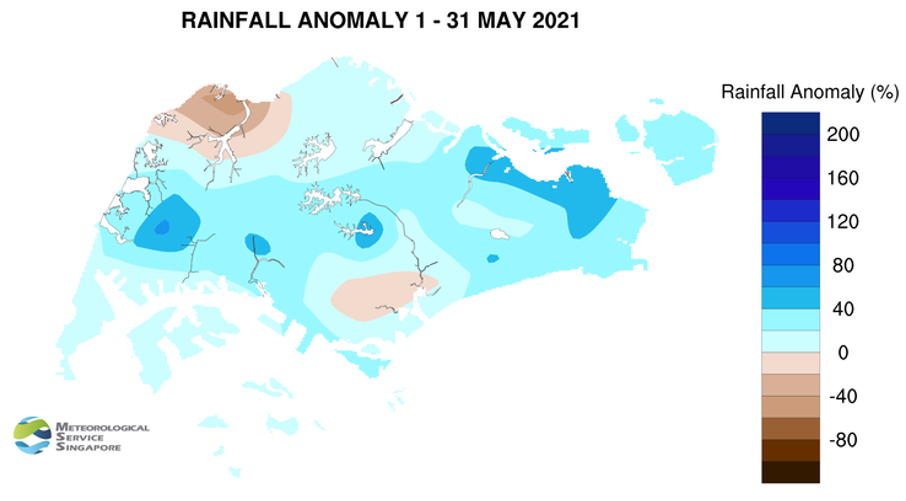Singapore, 1 Jun 2021 – The current warm and humid conditions are forecast to continue into the first fortnight of June 2021. During this period, the prevailing light and variable winds over Singapore and the surrounding region are forecast to strengthen and blow from the southeast or southwest. This signals the end of the inter-monsoon period and the start of the Southwest Monsoon season. The Southwest Monsoon season typically extends into September and is a generally drier season compared to other times of the year.
2 In the first half of June 2021, the monsoon rain band is forecast to lie over the northern Southeast Asia region. This is expected to bring generally dry, warm, and humid conditions over Singapore and the surrounding region on some days. Localised short-duration showers at times with thunder can be expected over a few parts of the island in the late morning and early afternoon on some days. In addition, on one or two days, Sumatra squalls moving from the Strait of Malacca to the South China Sea are expected to bring island-wide thundery showers with occasional gusty winds in the morning. The overall rainfall for the first half of June 2021 is likely to be below normal over most parts of Singapore.
3 During the fortnight, the nights are also expected to be warm and humid. Warm nights typically occur when the prevailing winds blow from the southeast and brings warm, humid air from the sea over the land. Night-time minimum temperatures of up to 28°C can be expected on some days. The daily temperature on most days is forecast to range between 25°C and 34°C. The daily maximum temperature could reach around 35°C on a few days, particularly when there are few clouds in the sky.
4 For updates of the daily weather forecast, please visit our MSS website (https://www.weather.gov.sg), NEA website (www.nea.gov.sg), or download the myENV app.
REVIEW (1 – 31 May 2021)
5 Inter-monsoon conditions prevailed over Singapore and the surrounding region in May 2021. During the month, the low-level prevailing winds were generally light and blew from the east, southeast or southwest.
6 In May 2021, thundery showers fell over parts of the island on most days, mainly in the late morning and afternoon. The showers were due to strong daytime heating of land areas and/or convergence of winds over Singapore and the surrounding vicinity. The heaviest thundery showers during the month occurred on 17 and 18 May 2021, particularly over the western and central parts of the island. On both days, convergence of winds over Singapore and the surrounding vicinity brought thundery showers in the late morning and early afternoon and again in the night. The highest rainfall recorded on 17 May 2021 was 117.2mm at Jurong West. On 18 May 2021, the daily total rainfall recorded at Toa Payoh was 132.0mm, which is the highest daily total for May 2021.
7 Climatologically, May is one of the warmest months of the year. In May 2021, the highest daily maximum temperature recorded across the island was at least 34°C on 18 days. The highest daily maximum temperature of 35.7°C was recorded at Marina Barrage on 11 May 2021. There were also a few warm nights where the night-time temperature was around 28°C particularly over the south-eastern part of the island.
8 Rainfall was slightly above average for most parts of Singapore in May 2021. The highest rainfall anomaly of 69% above average was recorded at Jurong. The anomaly was lowest at Kranji at 56% below average.
CLIMATE STATION STATISTICS
Long-term Statistics for June
(Climatological reference period: 1991 – 2020)
| Average daily maximum temperature | 31.9 °C |
| Average daily minimum temperature | 25.7 °C |
| Average monthly temperature | 28.5 °C |
| Average rainfall | 135.3 mm |
| Average number of rain days | 13 |
Historical Extremes for June
(Rainfall since 1869 and temperature since 1929)
| Highest monthly mean daily maximum temperature: | 33.2 °C (1997) |
| Lowest monthly mean daily minimum temperature: | 23.2 °C (1965) |
| Highest monthly rainfall ever recorded: | 378.7 mm (1954) |
| Lowest monthly rainfall ever recorded: | 21.8 mm (2009) |

